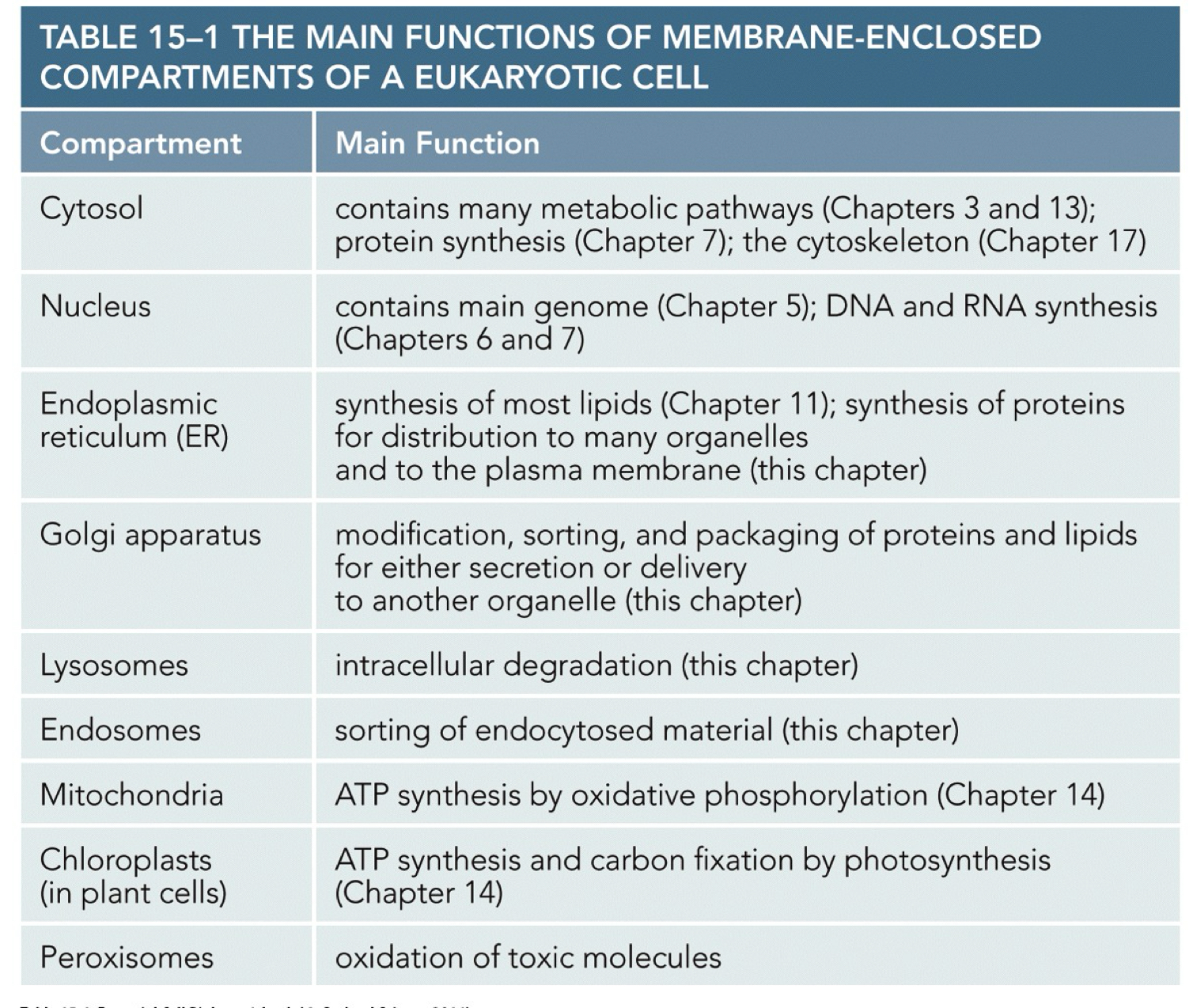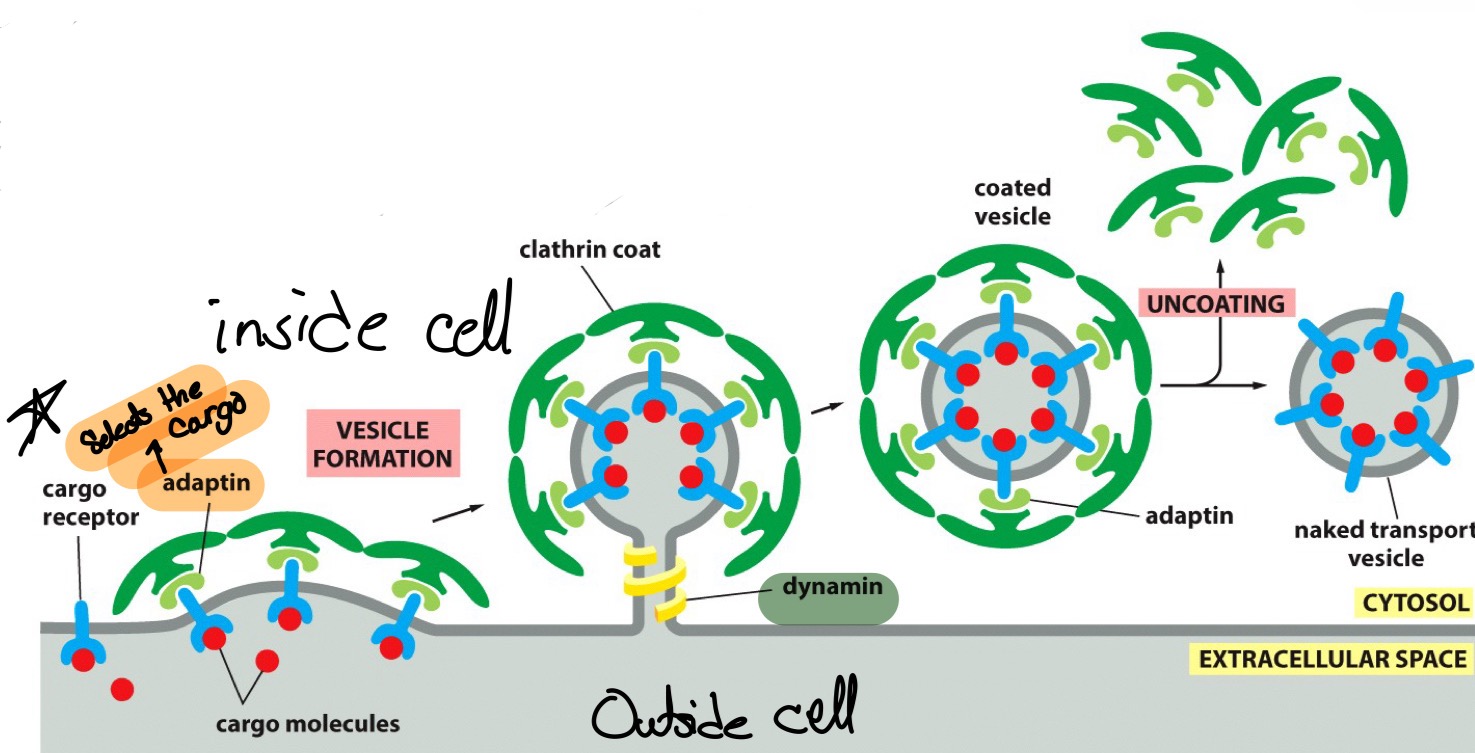Chp 15: Intracellular Compartments and Protein Transport
1/15
There's no tags or description
Looks like no tags are added yet.
Name | Mastery | Learn | Test | Matching | Spaced |
|---|
No study sessions yet.
16 Terms
What are the functions of all organelles on Table 15.1?

What organelles are part of the endomembrane system?
1. Nuclear Envelope: Surrounds the nucleus and connects with the endoplasmic reticulum.
2. Endoplasmic Reticulum (ER): Comprises rough ER (with ribosomes) and smooth ER (without ribosomes), involved in protein and lipid synthesis.
3. Golgi Apparatus: Modifies, sorts, and packages proteins and lipids for secretion or delivery to other organelles.
4. Lysosomes: Contain enzymes for digestion and waste processing.
5. Vesicles: Small membrane-bound sacs that transport materials within the cell.
6. Plasma Membrane: The outer boundary of the cell that regulates the entry and exit of substances.
How are the nucleus and nuclear membrane thought to have evolved?
Through invagination of the PM
What are the three mechanisms of protein transport, and during which mechanisms do the
proteins remain folded?
1.Transport through the nuclear pores (Proteins remain folded)
2.Transport across membrane
3.Transport by vesicle (endo- and exocytosis) (Proteins remain folded)
What are sorting signals?
Specific sequences of amino acids that direct proteins to the correct compartment/destination
How are proteins transported into the nucleus?
Through nuclear pores
How do chaperone proteins function in the matrix of the mitochondria or ER lumen?
Chaperones prevent misfolded or partially assembled proteins from leaving the ER. Misfolded proteins bind to chaperone proteins in the ER lumen and are thus retained there, whereas normally folded proteins are transported in transport vesicles to the Golgi. If the misfolded proteins fail to refold normally, they are transported back into the cytosol, and degraded. Accumulation of misfolded proteins in the ER lumen triggers an unfolded protein response (UPR).
A protein recently made in the ER travels through which pathway to get to the plasma membrane?
A protein recently made in the endoplasmic reticulum (ER) travels through the secretory pathway to get to the plasma membrane. Here’s how it works:
1. Endoplasmic Reticulum (ER): The protein is synthesized in the rough ER and properly folded and modified.
2. Transport Vesicles: Once the protein is ready, it is packaged into transport vesicles that bud off from the ER.
3. Golgi Apparatus: The vesicles then travel to the Golgi apparatus, where the protein undergoes further modifications, sorting, and packaging.
4. Secretory Vesicles: After processing in the Golgi, the protein is placed into secretory vesicles that are directed towards the plasma membrane.
5. Exocytosis: Finally, these vesicles fuse with the plasma membrane, releasing the protein outside the cell or inserting it into the membrane.
What are clathrin molecules and how do they facilitate endocytosis?
Clathrin molecules are protein structures that form basket-like cages that help shape membranes into vesicles. EM showing the sequence of events in the formation of a clathrin-coated pit.
Here’s how clathrin facilitates endocytosis:
1. Coat Formation: Clathrin molecules assemble into a basket-like structure on the cytoplasmic side of the plasma membrane. This process is initiated when specific receptors on the membrane bind to ligands (such as hormones or nutrients).
2. Membrane Invagination: As clathrin coats form, they pull the membrane inward, creating a pocket that begins to invaginate. This invagination is driven by the clustering of clathrin molecules and the underlying cytoskeletal elements.
3. Vesicle Budding: Once the invagination deepens, the membrane eventually pinches off, forming a vesicle that is coated with clathrin. This vesicle contains the ligands and any associated proteins.
4. Uncoating: After the vesicle is formed and detached from the plasma membrane, the clathrin coat is removed, allowing the vesicle to fuse with early endosomes for further processing.

What are adaptins and how do they facilitate endocytosis?
Adaptins are proteins that play a key role in the process of endocytosis by facilitating the binding of clathrin to specific cargo receptors on the cytoplasmic side of the plasma membrane.

What proteins are involved in directing transport vesicles to the target membrane?
Rab proteins, tethering proteins, and SNAREs
What provides the energy for fusion of a vesicle with the membrane?
SNARE
What is the unfolded protein response in the ER?
If the misfolded proteins fail to refold normally, they are transported back into the cytosol, and degraded. Accumulation of misfolded proteins in the ER lumen triggers an unfolded protein response (UPR).
What are the two faces of the Golgi apparatus, and what is their function?
1. Cis Face: The cis face is the side of the Golgi apparatus that faces the endoplasmic reticulum (ER). Its main function is to receive newly synthesized proteins and lipids from the ER. Here, the Golgi apparatus begins to modify these molecules, such as adding carbohydrate groups (glycosylation) or phosphate groups (phosphorylation).
2. Trans Face: The trans face is the side of the Golgi apparatus that faces the plasma membrane. Its function is to sort and package the modified proteins and lipids into vesicles for transport to their final destinations, which could be within the cell, incorporated into the plasma membrane, or secreted outside the cell.
What is the difference between regulated and constitutive exocytosis pathways?
Constitutive: Keeps continuously shipping them out
Regulated: only shipped when in response to a stimulus
What do the pseudopods of phagocytic cells do?
pseudopods help phagocytic cells to identify, engulf, and digest harmful particles